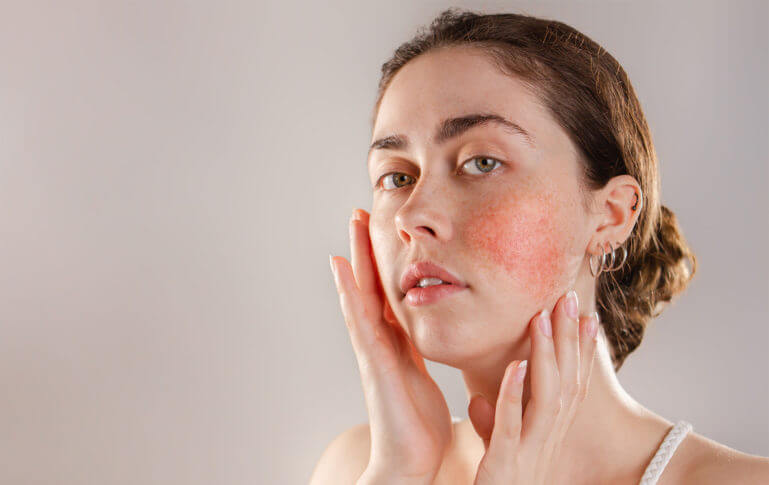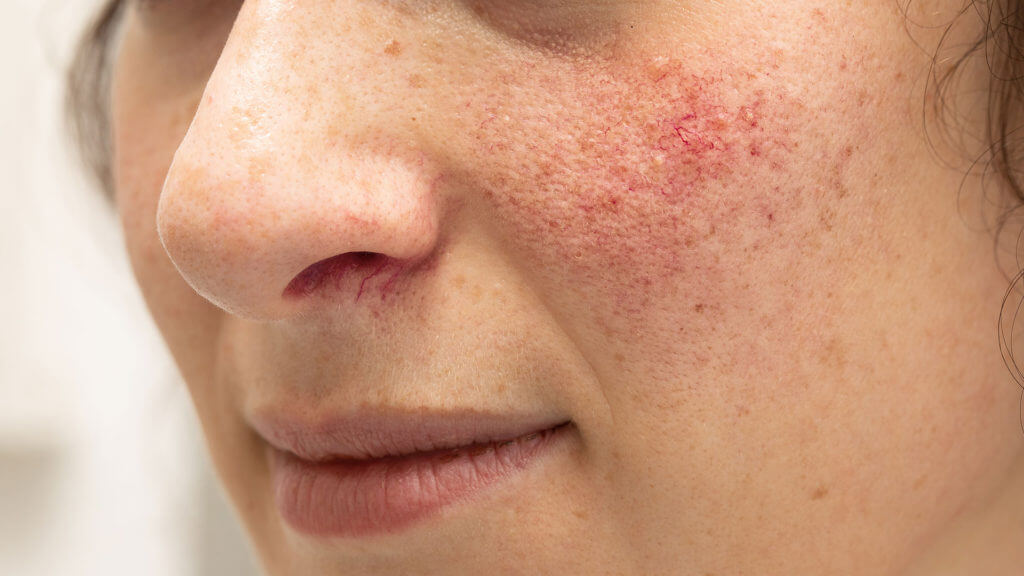Reduziere Rosacea
mit Sanubiom SkinCare Protect mit Phage Technology
- REDUZIERT Rötungen und Juckreiz
- FÖRDERT das Gleichgewicht der Haut
- STÄRKT die Hautschutzbarriere
Neurodermatitis, Rosacea

These three skin conditions are very similar and yet different: rosacea, couperose and neurodermatitis. This is because all three are associated with reddening of the skin in different areas of the face.
All of them are also suspected to have genetic causes. Nevertheless, it is important to know the differences and to have a dermatologist determine which disease is present.
With the right diagnosis, you can start a promising treatment – be it couperose, neurodermatitis or rosacea treatment.
What are the symptoms and treatment options, why do rosacea and couperose affect adults, but neurodermatitis may already affect a baby? We explain the differences.
Rosacea is a chronic inflammatory skin disease. It causes the typical symptoms, such as reddened areas. These usually occur in the area of the nose, cheeks and possibly the chin. The situation is very similar with couperose.
The difference between the two: Couperose is often seen as a precursor to a milder form of rosacea. Here, the redness on the face and body occurs in episodes, in so-called “flushes” .
These are triggered by certain factors, such as UV radiation, large temperature fluctuations, excitement, stress or spicy food.
In contrast, with rosacea this redness manifests itself at some point and no longer occurs only in phases. The skin on the face is permanently reddened, and later on, nodules and blisters can form on the sensitive skin.
In the most severe cases of rosacea, the typical rosacea nose, rhinophyma, occurs – usually in men. Rhinophyma is caused by nodules, papules and visible red veins that lead to a thickening of the nose, which usually remains permanent.
mit Sanubiom SkinCare Protect mit Phage Technology
Probiotic
Skin protection
In fact, despite existing evidence and suspicions, the exact circumstances under which rosacea occurs have not been clarified .
Similarly, although most researchers believe that couperose is a form of rosacea, the scientific community is not in complete agreement here either.

So although not all questions have been answered yet, we do know: Couperose does not necessarily develop into rosacea in every case. It is advisable for both rosacea and couperose to be monitored by a dermatologist.
If couperose does develop into rosacea, don’t panic: With a suitable and individually tailored rosacea treatment, the symptoms can be brought under control.
At first glance, rosacea and atopic dermatitis appear to be very similar. However, there are some significant differences. Patients are usually affected by rosacea for the first time between the ages of 30 and 50. Neurodermatitis, on the other hand, can already affect babies. Further differences also affect the care recommended in each case.
It is therefore crucial that you have your GP verify which of these skin conditions you actually suffer from. Two key differences between atopic dermatitis and rosacea:
On the one hand, the dilated blood vessels typical of rosacea and the clearly visible veins on the face do not occur in neurodermatitis.
On the other hand, neurodermatitis is accompanied by severe scaling of the skin, which is not found in rosacea.
This also has an impact on the recommended care. The dryness of the skin in the case of neurodermatitis can be treated with rich creams. These should be avoided at all costs in the case of rosacea.
Water-based emulsions and lotions should be used here. A layer of fat that is too occlusive can otherwise lead to heat build-up in rosacea skin, which promotes redness.